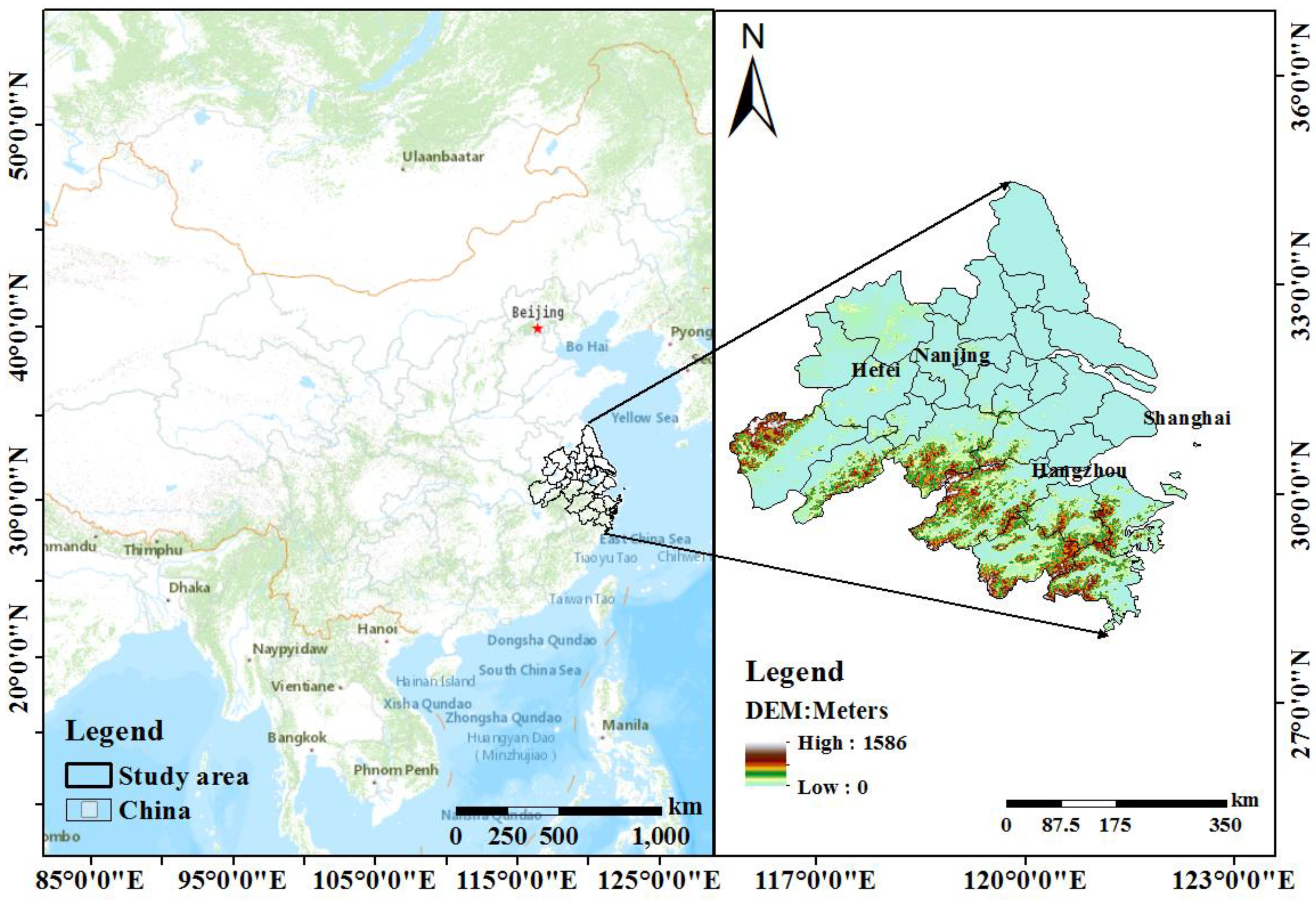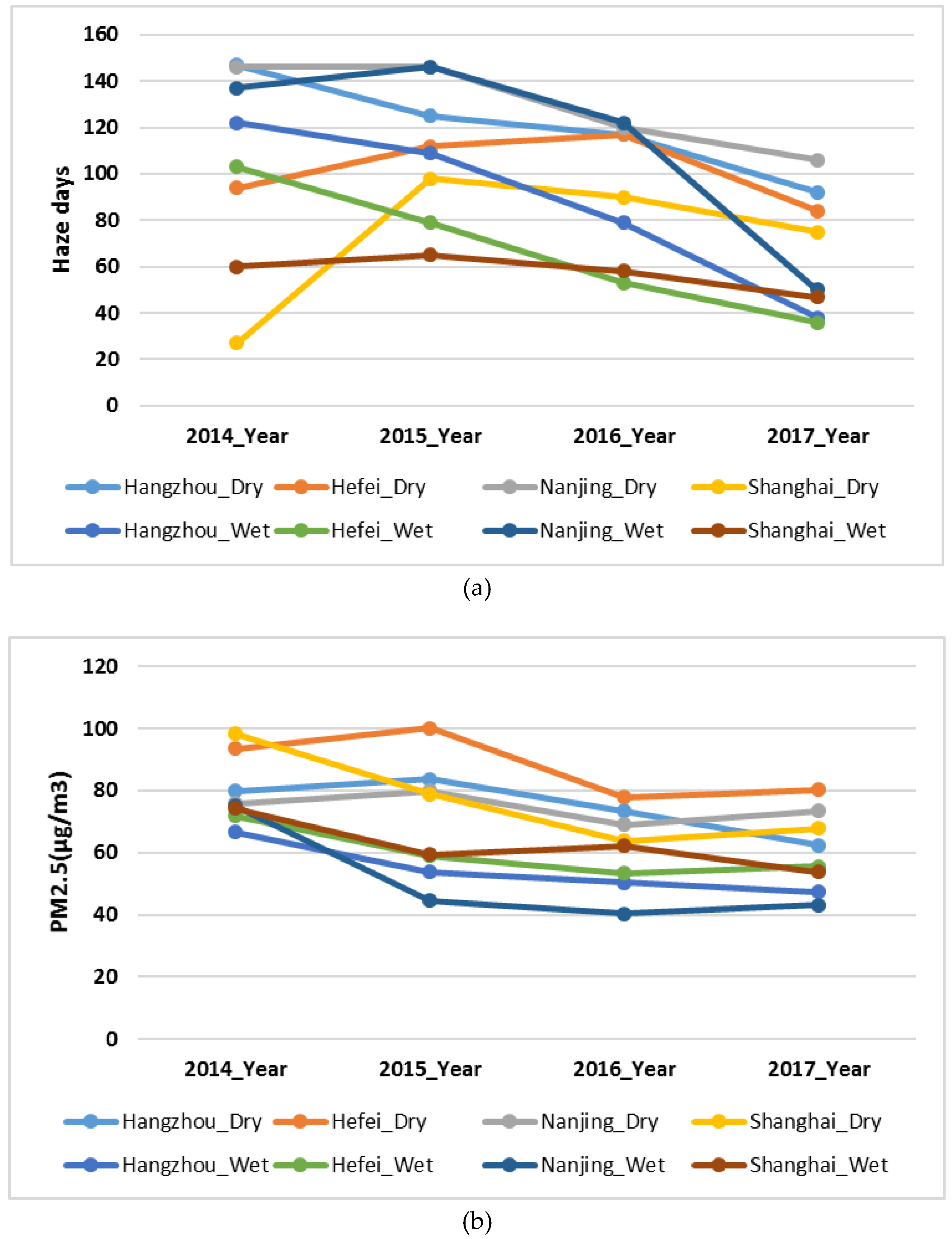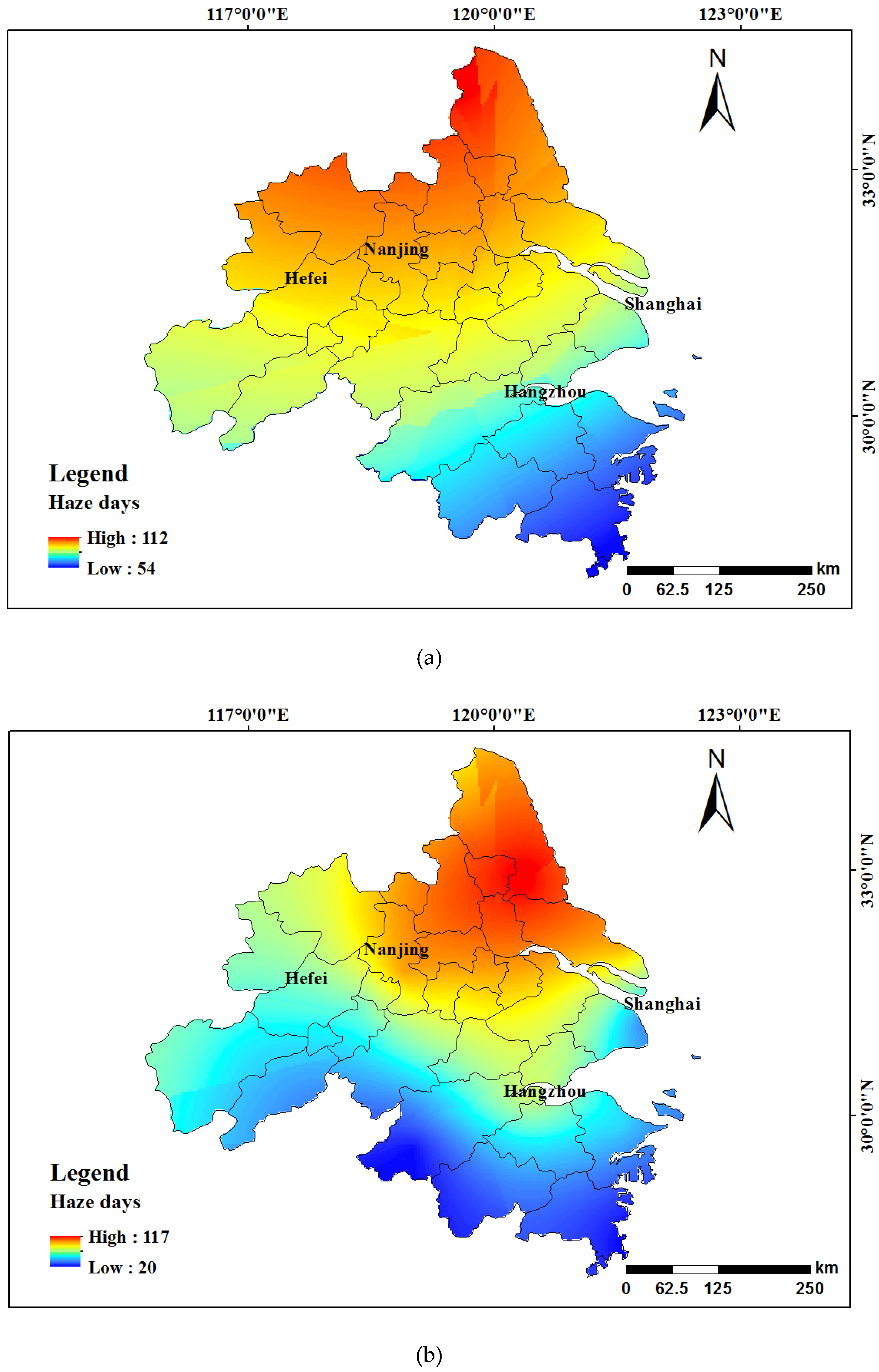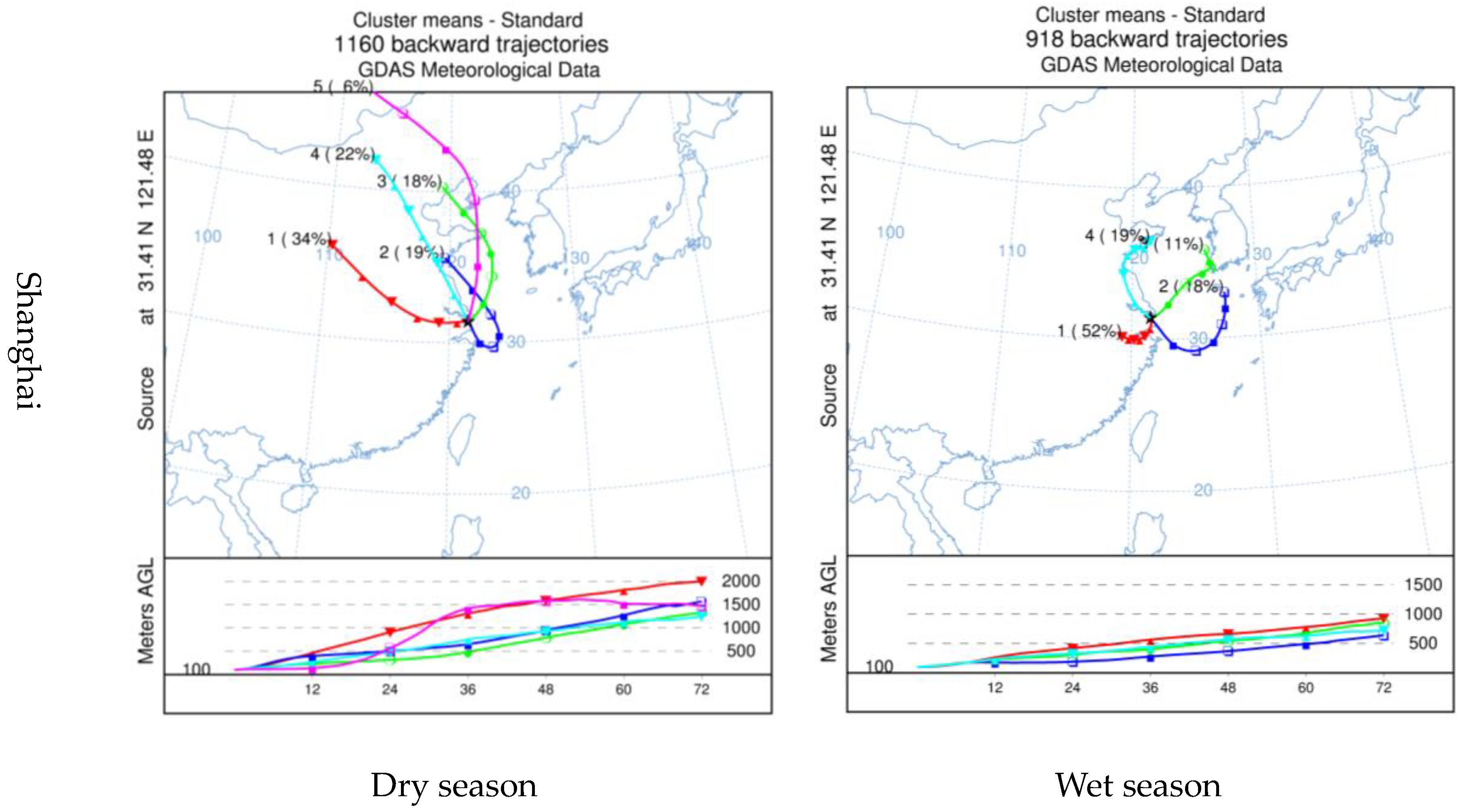Transport Paths and Identification for Potential Sources of Haze Pollution in the Yangtze River Delta Urban Agglomeration from 2014 to 2017
Abstract
:1. Introduction
2. Study Area and Data
2.1. Study Area
2.2. Data Source
2.2.1. Meteorological Data of the YRDUA
2.2.2. Reanalysis Data
3. Method
3.1. Definition of a Haze Day and Calculation of Backward Trajectory
3.2. Potential Source Contribution Function and Concentration Weighted Field
4. Results and Discussion
4.1. Haze Days Distribution in the YRDUA
4.2. Backward Trajectory Clustering Analysis
4.3. Potential Source Area and Pollution Level Analysis
5. Conclusion
5.1. Major Paths
5.2. Trajectories Altitude
5.3. Potential Source Area
Author Contributions
Funding
Acknowledgments
Conflicts of Interest
References
- Bouarar, I.; Wang, X.M.; Brasseur, G.P. Air Pollution in Eastern Asia: An Integrated Perspective; Springer International Publishing: Berlin, Germany, 2017. [Google Scholar]
- Xiao, Q.Y.; Wang, Y.J.; Chang, H.H.; Meng, X.; Geng, G.N.; Lyapustin, A.; Liu, Y. Full-coverage high-resolution daily PM2.5 estimation using MAIAC AOD in the Yangtze River Delta of China. Remote Sens. Environ. 2017, 199, 437–446. [Google Scholar] [CrossRef]
- Shao, P.; Xin, J.; An, J. The empirical relationship between PM2.5, and AOD in Nanjing of the Yangtze River Delta. Atmos. Pollut. Res. 2017, 8, 233–243. [Google Scholar] [CrossRef]
- Jiang, M.; Sun, W.W; Yang, G.; Zhang, D.F. Modelling seasonal GWR of daily PM2.5 with proper auxiliary variables for the Yangtze River Delta. Remote Sens. 2017, 9, 346. [Google Scholar] [CrossRef]
- He, Y. The Analysis of Two Haze Episodes from Different Sources over Yangtze River Delta in Winter. Master’s Thesis, Nanjing University of Information Science and Technology, Nanjing, China, 2017. [Google Scholar]
- Feng, Y.; Liu, H.N.; Sun, K. A sensitivity experiment of the air pollution transport in urban cluster over the Yangtze River Delta. Environ. Monit. Forewarn. 2016, 8, 5–12. (In Chinese) [Google Scholar]
- An, J.Y. Source Apportionment of Fine Particles in the Yangtze River Delta Region in Winter Season based on Air Quality Simulation. Master’s Thesis, Donghua University, Shanghai, China, 2015. [Google Scholar]
- Chen, W.C. Pollution Characteristics and Source Apportionment of Ambient Particulate Matter in Hangzhou, Yangtze River Delta of China. Master’s Thesis, Zhejiang University, Hangzhou, China, 2018. [Google Scholar]
- Yang, L.; Wu, Y.; Davis, J.M. Estimating the effects of meteorology on PM2.5 reduction during the 2008 Summer Olympic Games in Beijing, China. Front. Environ. Sci. Eng. China 2011, 5, 331–341. [Google Scholar] [CrossRef]
- Han, S.Q.; Wu, J.H.; Zhang, Y.F.; Cai, Z.Y.; Feng, Y.C.; Yao, Q.; Li, X.J.; Liu, Y.W.; Zhang, M. Characteristics and formation mechanism of a winter haze-fog episode in Tianjin, China. Atmos Environ. 2014, 98, 323–330. [Google Scholar] [CrossRef]
- Guo, L.J.; Guo, X.L.; Fang, C.G.; Zhu, S.C. Observation analysis on characteristics of formation, evolution and transition of a long-lasting severe fog and haze episode in North China. Sci. China-Earth Sci. 2015, 58, 329–344. [Google Scholar] [CrossRef]
- Koo, Y.S.; Yun, H.Y.; Choi, D.R.; Han, J.S.; Lee, J.B.; Lim, Y.J. An analysis of chemical and meteorological characteristics of haze events in the Seoul metropolitan are during January 12–18, 2013. Atmos. Environ. 2018, 178, 87–100. [Google Scholar] [CrossRef]
- Jiang, B.B. The development of Haze Events observed by multi-satellite retrievals and Meteorological Analysis in Eastern China. Master’s Thesis, Zhejiang University, Hangzhou, China, 2015. [Google Scholar]
- Jiang, B.B.; Zhang, X.Y.; Du, Y.; Huang, D.S. Establishing monitoring model of Haze event with multi-satellite data and application-a case: Yangtze River Delta. In Proceedings of the International Symposium on Optoelectronic Technology and Application, Beijing, China, 13 May 2014. [Google Scholar]
- Wu, Y.J.; Wang, P.; Yu, S.C.; Wang, L.Q.; Li, P.F.; Li, Z.; Mehmood, K.; Liu, W.P.; Wu, J.; Lichtfouse, E.; Rosenfeld, D.; Seinfeld, J.H. Residential emissions predicted as a major source of fine particulate matter in winter over the Yangtze River Delta, China. Environ. Chem. Lett. 2018, 16, 1–11. [Google Scholar] [CrossRef]
- Chen, Y.; Luo, B.; Xie, S.D. Characteristics of the long-range transport dust events in Chengdu, Southwest China. Atmos. Environ. 2015, 122, 713–722. [Google Scholar] [CrossRef]
- Liang, D.; Wang, Y.Q.; Ma, C.; Wang, Y.J. Variability in Transport Pathways and Source Areas of PM10 in Beijing during 2009–2012. Aerosol Air Qual. Res. 2016, 16, 3130–3141. [Google Scholar] [CrossRef]
- Zhou, S.; Liu, N.; Liu, C.S. Identification for potential sources for haze events in Shanghai from 2013 to 2015. Acta Scien. Circum. 2017, 37, 1835–1842. (In Chinese) [Google Scholar]
- Zhou, S.X.; Wang, X.; Gong, Z.Q.; Shi, C. Transport patterns of PM2.5 in the western Yangtze River Delta district, China. Acta Meteorol Sin. 2017, 75, 996–1010. [Google Scholar]
- Li, T.Y.; Deng, X.J.; Li, Y.; Song, Y.S.; Li, L.Y.; Tan, H.B.; Wang, C.L. Transport paths and vertical exchange characteristics of haze pollution in Southern China. Sci. Total. Environ. 2018, 625, 1074–1087. [Google Scholar] [CrossRef] [PubMed]
- Shi, C.N.; Yuan, R.M.; Wu, B.W.; Meng, Y.J.; Zhang, H.; Zhang, H.Q.; Gong, Z.Q. Meteorological conditions conducive to PM2.5 pollution in winter 2016/2017 in the Western Yangtze River Delta, China. Sci. Total. Environ. 2018, 642, 1221–1232. [Google Scholar] [CrossRef] [PubMed]
- Zong, Z.; Wang, X.P.; Tian, C.; Chen, Y.J.; Fu, S.F.; Qu, L.; Ji, L.; Li, J.; Zhang, G. PMF and PSCF based source apportionment of PM2.5, at a regional background site in North China. Atmos. Res. 2018, 203, 207–215. [Google Scholar] [CrossRef]
- Zeng, Y.; Hopke, P.K. A study of the sources of acid precipitation in Ontario, Canada. Atmos. Environ. 1989, 23, 1499–1509. [Google Scholar] [CrossRef]
- Mukherjee, A.; Agrawal, M. Assessment of local and distant sources of urban PM2.5, in middle Indo-Gangetic plain of India using statistical modeling. Atmos. Res. 2018, 213, 275–287. [Google Scholar] [CrossRef]
- Hsu, Y.K.; Holsen, T.M.; Hopke, P.K. Comparison of hybrid receptor models to locate PCB sources in Chicago. Atmos. Environ. 2003, 37, 545–562. [Google Scholar] [CrossRef]
- Li, T.Y.; Fan, S.J.; Deng, X.J.; Zhang, X.B.; Deng, T.; Li, F. Study on the regional transported effect of PM2.5 in Guangzhou area. J. Univers.Chin. Acad. Sci. 2014, 31, 403–409. [Google Scholar]
- Stull, R.B. An Introduction to Boundary Layer Meteorology; Kluwer Academic Publishers: Dordrecht, Netherlands, 1988; pp. 450–476. [Google Scholar]
- Yang, F.Y. The Atmospheric Boundary Layer Height Study Based on Ground-based Remote Sensing and Numerical Simulation. Master’s Thesis, Nanjing University, Nanjing, China, 2015. [Google Scholar]
- Ge, Y.; Wang, M.X.; Bai, X.; Yao, J.B; Zhu, Z.R. Pollution characteristics and potential sources of PM2.5 in Su-Xi-Chang region. Acta Scien. Circum. 2017, 37, 803–813. (In Chinese) [Google Scholar]
- Kang, N. A Study on Regional Numerical Simulation of Air Pollution. Master’s Thesis, Nanjing University of Information Science and Technology, Nanjing, China, 2006. [Google Scholar]








| City | Haze Days | Dry Season | Wet Season | 2014 | 2015 | 2016 | 2017 | ||||
|---|---|---|---|---|---|---|---|---|---|---|---|
| Dry | Wet | Dry | Wet | Dry | Wet | Dry | Wet | ||||
| Shanghai | 520 | 290 | 230 | 27 | 60 | 98 | 65 | 90 | 58 | 75 | 47 |
| Nanjing | 974 | 518 | 455 | 146 | 137 | 146 | 146 | 120 | 122 | 106 | 50 |
| Liyang | 752 | 419 | 333 | 128 | 113 | 104 | 87 | 88 | 73 | 99 | 60 |
| Lvsi | 934 | 485 | 449 | 132 | 137 | 119 | 123 | 109 | 92 | 125 | 97 |
| Dongtai | 1001 | 504 | 497 | 147 | 134 | 137 | 143 | 127 | 125 | 93 | 95 |
| Hangzhou | 829 | 481 | 348 | 147 | 122 | 125 | 109 | 117 | 79 | 92 | 38 |
| Dachen island | 81 | 61 | 20 | 8 | 9 | 22 | 8 | 16 | 1 | 15 | 2 |
| Ningbo | 586 | 361 | 225 | 107 | 90 | 100 | 71 | 88 | 41 | 66 | 23 |
| Qiandao Lake | 193 | 155 | 38 | 42 | 10 | 37 | 8 | 45 | 12 | 31 | 8 |
| Shengzhou | 536 | 355 | 181 | 104 | 58 | 92 | 72 | 95 | 30 | 64 | 21 |
| Zhoushan | 374 | 218 | 156 | 61 | 67 | 75 | 41 | 51 | 34 | 31 | 14 |
| Hefei | 668 | 407 | 261 | 94 | 103 | 112 | 79 | 117 | 53 | 84 | 36 |
| Anqing | 516 | 329 | 187 | 75 | 68 | 79 | 63 | 97 | 28 | 78 | 28 |
| Wuhu | 508 | 309 | 199 | 50 | 49 | 99 | 74 | 97 | 45 | 63 | 31 |
| City | Dry Season | Wet Season | 2014 | 2015 | 2016 | 2017 | ||||
|---|---|---|---|---|---|---|---|---|---|---|
| Dry | Wet | Dry | Wet | Dry | Wet | Dry | Wet | |||
| Hangzhou | 77.70 | 55.84 | 79.89 | 66.69 | 83.73 | 53.71 | 73.35 | 50.43 | 62.45 | 47.45 |
| Hefei | 90.40 | 61.62 | 93.43 | 71.75 | 100.17 | 58.98 | 77.82 | 53.31 | 80.23 | 55.55 |
| Nanjing | 75.57 | 50.39 | 75.88 | 74.99 | 79.83 | 44.65 | 68.99 | 40.31 | 73.53 | 43.09 |
| Shanghai | 76.69 | 61.96 | 98.40 | 74.20 | 78.93 | 59.35 | 63.90 | 62.28 | 67.90 | 53.79 |
© 2018 by the authors. Licensee MDPI, Basel, Switzerland. This article is an open access article distributed under the terms and conditions of the Creative Commons Attribution (CC BY) license (http://creativecommons.org/licenses/by/4.0/).
Share and Cite
Zhu, L.; Zhang, Y.; Kan, X.; Wang, J. Transport Paths and Identification for Potential Sources of Haze Pollution in the Yangtze River Delta Urban Agglomeration from 2014 to 2017. Atmosphere 2018, 9, 502. https://doi.org/10.3390/atmos9120502
Zhu L, Zhang Y, Kan X, Wang J. Transport Paths and Identification for Potential Sources of Haze Pollution in the Yangtze River Delta Urban Agglomeration from 2014 to 2017. Atmosphere. 2018; 9(12):502. https://doi.org/10.3390/atmos9120502
Chicago/Turabian StyleZhu, Linglong, Yonghong Zhang, Xi Kan, and Jiangeng Wang. 2018. "Transport Paths and Identification for Potential Sources of Haze Pollution in the Yangtze River Delta Urban Agglomeration from 2014 to 2017" Atmosphere 9, no. 12: 502. https://doi.org/10.3390/atmos9120502
APA StyleZhu, L., Zhang, Y., Kan, X., & Wang, J. (2018). Transport Paths and Identification for Potential Sources of Haze Pollution in the Yangtze River Delta Urban Agglomeration from 2014 to 2017. Atmosphere, 9(12), 502. https://doi.org/10.3390/atmos9120502






